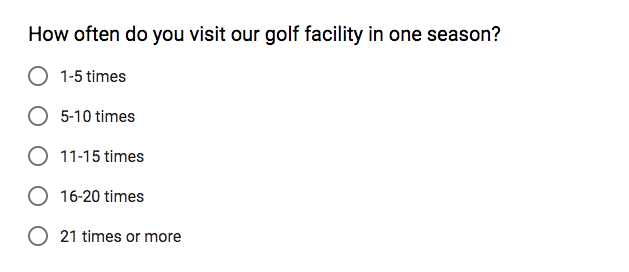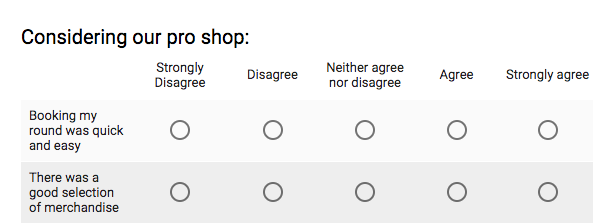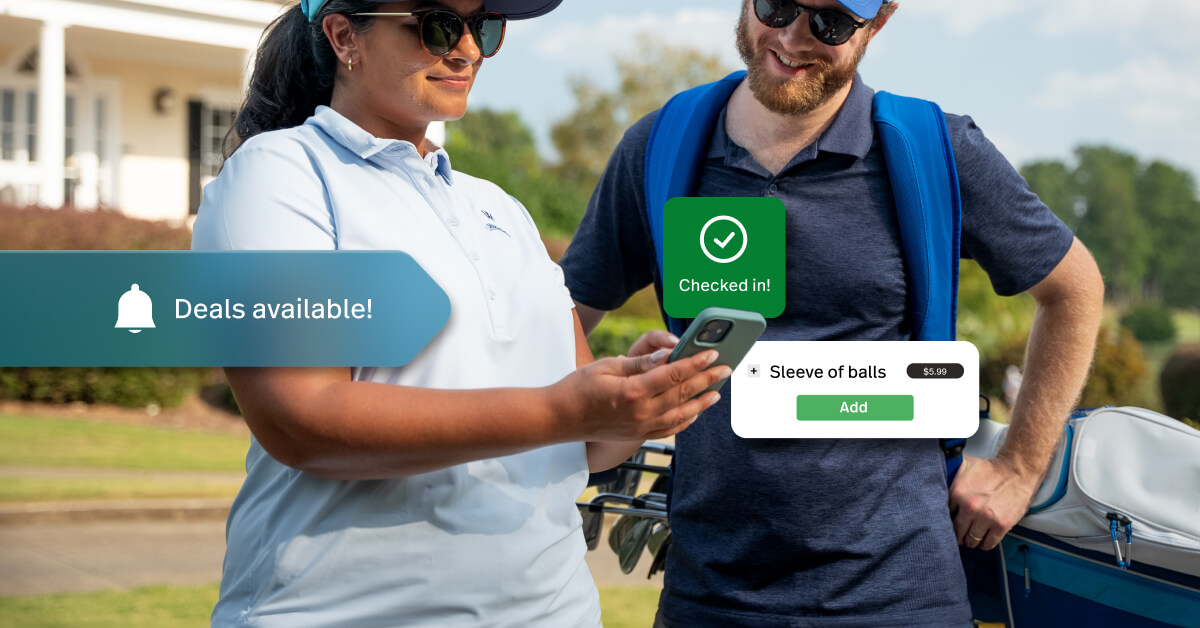
From high-end, semi-private golf facilities to beginner-friendly 9-hole courses, satisfied customers are the key to building a solid reputation and long-lasting relationships. And with more people than ever playing golf recreationally (up 53% in the past decade), there are more expectations than ever that need to be met. By running golf course surveys, golf facilities can gain the feedback they need to create amazing customer experiences.
- What is a customer satisfaction survey?
- Customer Satisfaction Score (CSAT)
- Net Promoter Score (NPS)
- Customer Effort Score (CES)
- Why use customer satisfaction surveys at golf courses?
- How to create golf course surveys that rate customer satisfaction?
- When should I send golf course surveys to customers?
- How should I distribute customer satisfaction surveys?
- What should I do with my golf course survey results?
Improve your business with golf course surveys
The importance of customer satisfaction can’t be overstated: according to the American Customer Satisfaction Index (ACSI), customer satisfaction is a vital asset to businesses that should be optimized and never ignored. Part of optimizing customer satisfaction, particularly for multi-faceted businesses like golf courses, is first to understand the customer experience. For instance:
- Are guests having a good time?
- Where do they see room for improvements?
- You can always turn to review forums for insights, but why not go to the source and ask your customers directly?
This is where golf course surveys come in
Golf course customer surveys are a proactive way for golf courses to gain valuable feedback from customers. This feedback, whether positive or negative, equips you to make appropriate business decisions that ultimately improve customer retention and grow your business.
After all, McKinsey research has shown that it can take three new customers to make up for the value of a single lost customer, so focusing on making your current customers happy is a worthwhile investment.
What is a customer satisfaction survey?
Customer satisfaction surveys help determine how happy your customers are with your business. Not only that, they can also provide specific insights into where your business’ strengths and weaknesses lie, such as the condition of the course or facilities, staff interactions and more.
Types of customer satisfaction survey metrics
There are three main metrics used when talking about golf course surveys that gauge customer satisfaction. They are:
- Customer Satisfaction Score (CSAT)
- Net Promoter Score (NPS)
- Customer Effort Score (CES)
Customer Satisfaction Score (CSAT)
CSAT is used to measure customer satisfaction with products or interactions by calculating a percentage based on survey responses on a scale (i.e. 0 to 10 or 😞 to 😀).
Customer satisfaction scores are tallied by dividing all positive responses (i.e. in the 8-10 range) by the total number of responses and multiplying that number by 100. This results in a CSAT percentage, which will indicate the overall level of satisfaction for a particular interaction with your golf course.
Net Promoter Score (NPS)
NPS is a benchmark that you can use to gauge how customers feel about their overall relationship to your business, rather than a specific experience or product. NPS golf course survey questions are typically asked with a range of answers from 0 to 10. Respondents are then are classified into three groups:
- 9-10: These are your promoters; they love what you’re doing.
- 7-8: These are considered passives; they are not sold on what you’re offering but also not dissatisfied enough to say so
- 0-6: These are detractors; they are the ones who will spread the word about their dissatisfaction
The total number of promoters minus the total number of detractors is your Net Promoter Score. Golf courses can learn a lot about themselves and their operations through these results.
Customer Effort Score (CES)
CES is a metric that reflects the effort a customer makes when dealing with your business, whether it’s making a reservation or having an issue resolved.
CES surveys are usually based on questions like “how seamless was your interaction today on a scale of ‘not at all to very’?”, with the score calculated by dividing the number of customers who say their interaction was “seamless” or “very seamless” by the total number of respondents.
High CES scores are highly sought after, especially considering that 91% of customers are likely to refer or recommend a business that they’ve had a good, low-effort interaction with.
Why use customer satisfaction surveys at golf courses?
Businesses conduct these types of surveys in an effort to better understand their customers and ensure that they are delivering exceptional services. Your customer retention, sales, revenues and bottom line are all impacted by these results and conducting golf course surveys gives your business actionable insights for improvement.
How to create golf course surveys that rate customer satisfaction?
The quality of feedback you get from customers is highly dependent on the quality of the survey you send them. In other words, you need to ask the right golf course survey questions!
Years of research and advanced statistical analysis have gone into developing best practices for engaging customers in surveys. The most important finding? Surveys should be easy for customers to understand and complete.
Here are different types of golf course survey questions you can consider.
Binary questions
These questions have two possible answers, like “Yes or No” or “True or False”. Using binary questions in a survey allows you to collect straightforward answers that are easy to compile and which don’t require much effort from your customers.
Keep your questionnaire short and sweet. Asking too many binary questions—or survey questions in general—can lead to “survey fatigue”, which can contribute to inaccurate responses and, even worse, a poor customer interaction in itself.
Ideally, your survey should take no longer than five minutes (amounting to about 10 questions).

Multiple choice questions
Multiple choice questions are helpful for collecting and categorizing demographic information. Each question typically includes three to five mutually exclusive variables, each representing a segment in which any respondent would fit.
Multiple choice questions are handy for determining various criteria, including a player’s golfing ability or frequency of play. With these categories, you can categorize players based on their responses and analyze differences between each group.
Be sure that you are asking questions that provide real value, and limit the number of questions you ask to avoid survey fatigue.

Likert scale
Likert scale golf course survey questions are one of the most common formats used to measure customer satisfaction. These involve more nuance than binary questions, allowing customers to place their level of satisfaction on a scale.
For example: “The fairways were well maintained during my round”, to which respondents can decide how strongly they agree or disagree.
The main benefit of the Likert Scale is that it facilitates segmentation, allowing you to analyze trends and similarities between customers who entered the same response.
You can also track response changes over time to see whether elements of your golf facility are improving. The main limitation with this type of survey is that it doesn’t provide any qualitative analysis. You might figure out that a customer “strongly disagreed” with the statement, but you won’t know why.

Open-ended questions
Integrating open-ended golf course survey questions into a customer satisfaction survey helps provide deeper, more specific insights.
This qualitative feedback is essential, as it helps you understand what each customer values and where they may have criticism. Addressing these direct critiques is critical to ensuring customer satisfaction and retention.
When composing a golf course survey to send to your members or daily fee golfers, try using a combination of different question types.

Golf course customer satisfaction survey tips
- Make sure survey questions are concise and easy to understand
- Write surveys that take no more than five minutes to complete
- Combine different types of survey questions for both quantitative and qualitative data
- Convert poor feedback into actionable improvements to your products and services
- Follow up with respondents, particularly when it comes to open-ended questions
When should I send golf course surveys to customers?
The timing of your customer satisfaction surveys is as important as the content. In general, there are two optimal times to deploy a customer satisfaction survey:
- Immediately after a round, customer interaction or specific event (ideal for non-members or new products)
- Periodically on a set cadence (ideal for regular users or members)
Within 1-2 days of an interaction
Sending a customer satisfaction survey in the immediate aftermath of a specific interaction can have several benefits.
For one, it can give you insights into the experiences of new customers, such as daily fee golfers, guests and tournament participants.
This type of survey can also be sent out to regular customers to gauge the success of a new product or service. The optimal timing for these surveys should be within a few days of a round, meal or pro shop purchase.
Periodically or on a set cadence
When it comes to private club members or regular customers at a public facility, periodic surveys can help you keep up with changing trends or customer sentiment.
This type of survey should be frequent enough without risking your customers feeling inundated. After all, you don’t want the customer satisfaction survey itself to be a point of contention for customers.
In general, it’s a good idea to send out a new survey once a quarter, preferably earlier in the week when people are most likely to respond.
How should I distribute customer satisfaction surveys?
There are several pathways for distributing golf course surveys, each with different benefits.
The most common method for sharing golf customer satisfaction surveys is via email. This method is particularly effective because your golf course already has an email list at its disposal.
One of the key benefits of sending customer satisfaction surveys by email is that it is easy to use automated personalization, a feature that can increase email open rates by 26%.
Email is an effective way to distribute surveys on a broader scale and track key data points such as open, click and completion rates. Remember: answering the survey should be as effortless as possible, so ensure you add it directly to the body of your email if possible.
Website
Golf courses can also add customer satisfaction surveys directly to your website. If you are using this as a distribution method, it’s generally a good idea to stick to one simple question, ideally that pertains to the customer’s website experience.
Given that 75% of golfers said it was important for golf courses to offer a good website experience, a website-based survey could be a great way to determine a Customer Effort Score related to your website’s ease of use and online booking process.
Online chatbot
If your golf course offers an online chat feature, you can integrate relevant survey questions at the end of an interaction to gauge how the experience went and how satisfied the customer was with your agent or chatbot’s support.
A suitable survey prompt in this context would be: “How satisfied are you with your support experience?” on a scale of “very dissatisfied to very satisfied”.
QR codes
QR codes are an excellent way to get members or guests to answer a survey while they are on site. You can strategically place QR codes on print media:
- Around the golf course itself
- In the golf cart
- In the pro shop
- At the halfway house
- In the locker room
- Around the dining room
- Or on a printed receipt
This will give each customer the chance to share their feedback. Since customers are choosing to opt in, a QR code survey can be more in-depth than a pop-up chat or website survey.
SMS (Text message)
Like email, SMS is a great way to reach many or targeted groups of your customers for feedback, and it has a very high open rate of 98%.
SMS surveys are particularly effective for interaction-specific surveys. For example: “How would you rate your recent golf lesson out of 1-10”. Just be wary of running too many SMS surveys to the same customer set, as they can feel like a nuisance if they are sent too often.
What should I do with my golf course survey results?
You’ve sent out your surveys and your customers have taken the time to submit responses, so what’s next?
It’s time to analyze survey responses to determine exactly where your business is excelling and where it may be falling short of expectations. From there, you can implement strategic changes that take your golf course to the next level.
Here are some ways you can evaluate data collected from surveys and put together an action plan.
Communicate feedback to relevant departments
Survey results and data are only useful if they are shared with the appropriate teams. If your customer satisfaction team identifies recurrent dissatisfaction with course conditions, this feedback needs to make it to your course superintendent. Similarly, any food and beverage complaints should go to your dining room manager and so on.
Close the loop to meet customer expectations
Follow up on customer feedback in a meaningful way. Don’t let the data from your survey responses lie dormant. Be proactive and start showing the customers that you value their feedback and are taking steps to address their concerns. By taking action, you demonstrate your desire to provide a quality product. Remember the goal: happy, loyal customers!
Find trends in the data you’ve gathered
The gradual change in the feedback you receive from customers is the metric by which you should gauge your operation and the evolution of your customer experience.
You can identify these trends by graphing the data accumulated. Are you heeding customer opinions and acting upon them? If so, you should see improvement in your results.
The power of being heard with golf course customer satisfaction surveys
Always remember: your customers want to be heard! Integrating surveys into your customer experience is vital to not only improving your business and overall customer satisfaction but also showing your customers that you care about their opinions and feedback.
In the end, whether you add a new product to your golf shop, upskill your staff, update your instruction programs, improve your pace of play monitoring, or simply clean the bathrooms better, improving customer satisfaction in a measurable way is critical in the service industry.
If you’re looking for golf course management software that can help you communicate with your customers effectively and deliver efficient customer experiences at the course and online, talk to one of our experts today.

News you care about. Tips you can use.
Everything your business needs to grow, delivered straight to your inbox.





